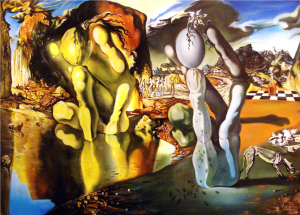NARKİSSOS ve METAMORPHOSE

Uyandı birden derin uykusundan
Ete kemiğe büründü yeniden
Durgun suyun kıyısından
Çayırların çimenlerin arasından
Kaldırdı başını, baktı uzaklara
Uzaktaki mor dağlara
Kulağında o ses
E k h o o o
Topladı olanca gücünü
Haykırdı dağlara, bir daha
E k h o o o
Bulunmalı o ses
Çalmadık kapı bırakmadı, yoruldu
Sonunda dayadı sırtını bir yaşlı çınara
Çıkageldi tunç toynaklı, altın boynuzlu Kyrenitis
-Nedir derdin söyle bana
Dedi, kuyruğunu sallaya sallaya
-Kim gönderdi seni bana
-Ida’nın tepesinden geldim
Kıskanç Hera bağışladı, sonunda
Selam yolladı efendim Artemis sana
Dedi, öyle olmaz aç biilaç
-İşte zeytin, işte elma, işte üzüm
Ye iç kanlan, canlan…
Önce utandı, sonra baktı
Kyrenitis’in parlayan boynuzuna
Durgun sudaki güzel yüzü geldi aklına
Kulağında hiç durmadan çağıran o ses
E k h o o o
İkisinden biri, ikisinden biri dedi
Ya o yüz …Ya o ses…
Yetti artık dedi, söyleyin Teiresias’a
Ben artık kendimi bilmek isterim
Kyrenitis onu sırtına aldı
Zeus’un şimşekleriyle yarıştılar
Dağları tepeleri aştılar
Zephyros
Ellerinin yumuşaklığı saçlarının arasında
Sözümdür dedi Narkissos
Hayalimi onun tenine giydireceğim
Durgun suya değil çağlayanlara koşacağım
Haber salın hem Dionysos’a, hem Apollon’a
Çalsın dithyramboslar, söylesin bakkhalar
Çağırın tüm tanrıları, tüm tanrıçaları
Kephisos, Liriope tanığımız olsunlar
Sevgilim Ekho’ya dünyanın en güzel çiçeğini verecek
Ona dünyanın en güzel düğününü yapacağım.
aCp 27.12.2019
NOT:
Narkissos: Nergis çiçeğine adını veren mitoloji kahramanı
Kyrenitis : Artemis’in geyiği
Artemis : Avcı tanrıça
Ekho: Eko, yani yankıya adını veren mitoloji kahramanı
Liriope: Su perisi Nymphe soyundan bir güzel
Kephissos: Irmaklar tanrısı
Zeus : Baş tanrı
Hera: Zeus’un eşi
Zephyros: Batı rüzgârının tanrısı
Dionysos: Şarap tanrısı
Apollon: Işık tanrısı
Teiresias: Yanılmaz kör kahin
Salvador Dali – London Tate Gallery
Metamorphose de Narcisse 1937
© Salvador Dali, Gala-Salvador Dali Foundation/DACS, London 2020
License this image
ARTIST
Salvador Dalí 1904–1989
ORIGINAL TITLE
Métamorphose de Narcisse
MEDIUM
Oil paint on canvas
DIMENSIONS
Support: 511 × 781 mm
frame: 820 × 1092 × 85 mm
COLLECTION
Tate
ACQUISITION
Purchased 1979
This painting is Dalí’s interpretation of the Greek myth of Narcissus. Narcissus was a youth of great beauty who loved only himself and broke the hearts of many lovers. The gods punished him by letting him see his own reflection in a pool. He fell in love with it, but discovered he could not embrace it and died of frustration. Relenting, the gods immortalised him as the narcissus (daffodil) flower. For this picture Dalí used a meticulous technique which he described as ‘hand-painted colour photography’ to depict with hallucinatory effect the transformation of Narcissus, kneeling in the pool, into the hand holding the egg and flower. Narcissus as he was before his transformation is seen posing in the background. The play with ‘double images’ sprang from Dalí’s fascination with hallucination and delusion.
This was Dalí’s first painting to be made entirely in accordance with the paranoiac critical method, which the artist described as a ‘Spontaneous method of irrational knowledge, based on the critical-interpretative association of the phenomena of delirium’ (The Conquest of the Irrational, published in The Secret Life of Salvador Dalí, New York 1942). Robert Descharnes noted that this painting meant a great deal to Dalí, as it was the first Surrealist work to offer a consistent interpretation of an irrational subject.
The artist said to Descharnes of this picture:
A painting shown and explained to Dr. Freud.
Pedagogical presentation of the myth of narcissism, illustrated by a poem written at the same time.
In this poem and this painting, there is death and fossilization of Narcissus.
The poem to which Dalí referred was published in 1937, in a small book by the artist entitled Metamorphosis of Narcissus. The book also contains two explanatory notes printed facing a colour reproduction of the painting, the first of which reads:
WAY OF VISUALLY OBSERVING THE COURSE OF THE METAMORPHOSIS OF NARCISSUS REPRESENTED IN THE PRINT ON THE OPPOSITE PAGE:
If one looks for some time, from a slight distance and with a certain ‘distant fixedness’, at the hypnotically immobile figure of Narcissus, it gradually disappears until at last it is completely invisible.
The metamorphosis of the myth takes place at that precise moment, for the image of Narcissus is suddenly transformed into the image of a hand which rises out of his own reflection. At the tips of its fingers the hand is holding an egg, a seed, a bulb from which will be born the new narcissus – the flower. Beside it can be seen the limestone sculpture of the hand – the fossil hand of the water holding the blown flower.
When he met Sigmund Freud in London in 1938, Dalí took this picture with him as an example of his work, as well as a magazine containing an article he had written on paranoia. Freud wrote the following day to Stefan Zweig, who had introduced them, that ‘it would be very interesting to explore analytically the growth of a picture like this’.
Further reading:
Tate Gallery 1978-80 Illustrated Catalogue of Acquisitions, London 1981, pp.85-9, reproduced p.85
Robert Descharnes, Gilles Néret, Salvador Dalí: The Paintings, 2 volumes, Köln 1994, pp.288-9, 299, 757, reproduced pl.645 in colour
Dawn Ades, Dalí, revised edition, London 1995, pp.132-3, reproduced p.131 in colour
Terry Riggs
March 1998
Does this text contain inaccurate information or language that you feel we should improve or change? We would like to hear from you.
